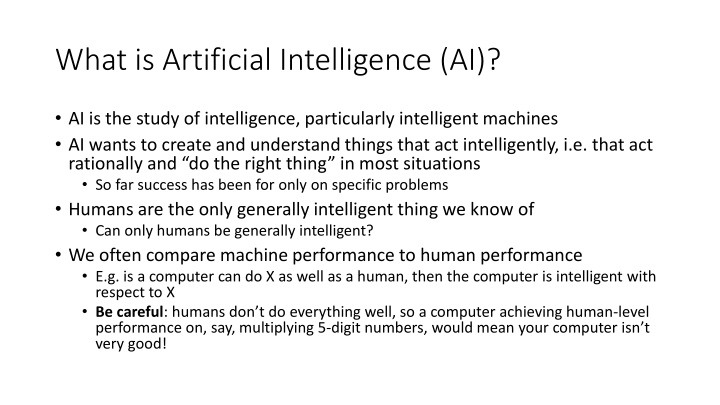
History and Evolution of Artificial Intelligence: A Timeline
Delve into the rich history of Artificial Intelligence (AI) through a comprehensive timeline that highlights key milestones and contributions from influential figures such as Alan Turing, John McCarthy, and Edward Feigenbaum. Explore the origins of AI, from the first artificial neural networks in 1943 to the development of expert systems in the 1980s, shaping the path towards creating intelligent machines and systems that mimic human cognitive abilities.
Download Presentation

Please find below an Image/Link to download the presentation.
The content on the website is provided AS IS for your information and personal use only. It may not be sold, licensed, or shared on other websites without obtaining consent from the author. If you encounter any issues during the download, it is possible that the publisher has removed the file from their server.
You are allowed to download the files provided on this website for personal or commercial use, subject to the condition that they are used lawfully. All files are the property of their respective owners.
The content on the website is provided AS IS for your information and personal use only. It may not be sold, licensed, or shared on other websites without obtaining consent from the author.
E N D
Presentation Transcript
What is Artificial Intelligence (AI)? AI is the study of intelligence, particularly intelligent machines AI wants to create and understand things that act intelligently, i.e. that act rationally and do the right thing in most situations So far success has been for only on specific problems Humans are the only generally intelligent thing we know of Can only humans be generally intelligent? We often compare machine performance to human performance E.g. is a computer can do X as well as a human, then the computer is intelligent with respect to X Be careful: humans don t do everything well, so a computer achieving human-level performance on, say, multiplying 5-digit numbers, would mean your computer isn t very good!
1943: described the first artificial neural networks Warren McCulloch Walter Pitts
1948-50: wrote probably the first computer chess program (although never got it running on a computer) 1950: proposed the Turing Test as a test of general-purpose computer intelligence Also well known for his work in foundational computer science (Turing machines), and helping to crack the German Enigma code during WW2 Alan Turing
1955: coined the term Artificial Intelligence 1958: designed the LISP programming language (used in many early symbolic AI programs) Involved in much foundational AI research, in particular applications of logic John McCarthy
1951: created the first randomly wired neural net learning machine (hardware) 1969: with Seymour Papert, wrote the influential book Perceptrons that showed fundamental limitations of early neural nets Along with John McCarthy, one of the major leaders of early AI work
1965 onwards: helped create the influential expert system Dendral (for identifying unknown organic molecules), and other expert systems Proponent of heuristics and rule-based AI 1980s: expert-system shells for adding rule-based AI to programs were available Edward Feigenbaum
Examples of heuristic rules from the MYCIN expert system
1978 - onwards: one of a small group of enthusiastic neural net researchers Involved in a lot of fundamental modern work on neural nets 2011 - onwards: major success with neural net model, achieving best performance in applications such as image recognition and speech understanding Geoffrey Hinton
